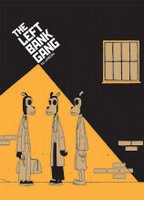Graphic Lit: Left Bank Gang & Halo
 One of the most consistent, prolific and interesting cartoonists in recent years is the Norwegian artist known simply as Jason.
One of the most consistent, prolific and interesting cartoonists in recent years is the Norwegian artist known simply as Jason.In books like "Hey, Wait," "The Iron Wagon" and "Why Are You Doing This?" he moves nimbly from humor to tragedy to crime noir, all while utilizing the same, iconic characters — white-eyed, geometrically precise anthropomorphic cats, dogs and birds that tend to resemble the grim reaper more than their animal counterparts.
His latest book, "The Left Bank Gang," takes a rather unusual literary conceit. Set in Paris in the 1920s, it imagines the great "Lost Generation" of authors — Hemingway, Fitzgerald, Joyce and Pound — as cartoonists rather than writers.

Things are not going well for this group of artists. Poverty and obscurity dog their heels, their wives (at least in Fitzgerald’s case) harangue them constantly, and they seem to spend more time drinking in cafes than actually sitting down and drawing.
Then, rather abruptly, the story takes a dramatic shift and becomes a "Pulp Fiction"-esque crime story as Hemingway and his band of cohorts decide to plan a big robbery.
The rather bleak joke at the heart of this book is just how tough and unrewarding a profession comics can be. To be a cartoonist, he seems to be saying, is to work without the benefit of financial reward or any sort of acclaim at all.
"It’s because we read comics when we were kids," Joyce laments at one point. "If we’d played football or climbed trees we’d be normal today. We’d have real jobs. We’d be bus drivers or carpenters, and we’d be happy."
Jason plays with the narrative at the end of the book, showing the robbery from several different perspectives, but it’s to his immense credit that the reader never has any trouble figuring out who’s who or what’s going on. By the grim, sad end, you will find yourself completely drawn in and captivated by this alternative universe.
Hemingway may never have made it as a cartoonist, but Jason makes a helluva good one.
"Halo" comes to comics
One of the more highly anticipated books of this year is "Halo: The Graphic Novel" (Marvel, $24.99).
That anticipation is primarily due to the popularity of the source material. "Halo," of course, is the almost ridiculously popular video game about a helmeted space marine who battles hordes of vicious alien armies.
The game has already spun off into a series of books, so it’s only natural that they’d try to attempt a comic as well. Unfortunately, the book is a rather dull affair, continuing none of the thrills from the actual video game.
The title itself is a bit misleading. "Halo" is not really a graphic novel, per se, but a collection of four short stories set in the game’s universe, with a lengthy number of pin-up pages rounding out the back of the book.
The first tale is drawn by Simon Bisley and is an unreadable mess. I’ve never been a big fan of Bisley’s work (think Boris Vallejo on PCP), and this particular tale, involving an alien warrior who must fend off an attack from a dangerous otherworldly antagonist, does little to persuade me otherwise. The story is too cluttered, too overly detailed and too over the top to be able to figure out what’s going on at any one moment.
The other stories fare little better. Bungie, the game’s developers, opted to tell apocryphal stories concerning supporting characters or places in the game, and as a result the book feels rather inconsequential.
The great French artist Moebius is particularly ill-used, drawing dull cityscapes and scenes of destruction when he could be delineating one of his surreal psychedelic fantasies (his layouts are rather inventive though).
Ultimately, I have a hard time imagining anyone but the most devoted "Halo" fan caring about this book. It’s far too obsessed with its own minutiae to fully engage a less hard-core reader. Just play the game instead.

Copyright The Patriot-News, 2006
0 Comments:
Post a Comment
<< Home